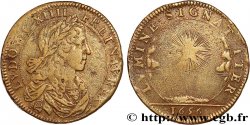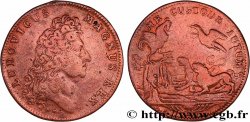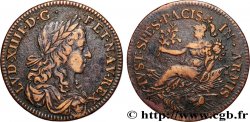E-auction 640-644677 - LOUIS XIV THE GREAT or THE SUN KING Préliminaires de la Paix de Munster n.d.
You must signin and be an approved bidder to bid, LOGIN TO BID. Accounts are subject to approval and the approval process takes place within 48 hours. Do not wait until the day a sale closes to register. Clicking on « bid » constitutes acceptance of the terms of use of cgb.fr private e-auctions.
Bids must be placed in whole Euro amounts only. The sale will start closing at the time stated on the item description; any bids received at the site after the closing time will not be executed. Transmission times may vary and bids could be rejected if you wait until the last second. For further information ckeck the E-auctions F.A.Q.
NO BUYER'S FEE.
NO BUYER'S FEE.
Type : Préliminaires de la Paix de Munster
Date: n.d.
Metal : brass
Diameter : 24,50 mm
Orientation dies : 6 h.
Weight : 4,77 g.
Edge : lisse
Puncheon : sans poinçon
Rarity : R1
Coments on the condition:
Patine hétérogène avec des traces d’usure, quelques coups et rayures. Taches d’oxydation et traces de nettoyage
Catalogue references :
Obverse
Obverse legend : LVD. XIIII. D. G. FR. ET. NAV. REX.
Obverse description : Buste de Louis XIV, type Guéant Prieur 218L.
Reverse
Reverse legend : IVSTIS. SPES. - PACIS. IN. ARMIS. .
Reverse description : La Paix ou la France assise à gauche sur des armes, tenant une branche de laurier et une corne d'abondance.
Reverse translation : L'espoir de Paix repose sur les armes.
Commentary
Suite au Traité de Munster, la France est confirmée dans la possession des Trois-Évêchés de Metz, Toul et Verdun annexés de fait depuis un siècle.
La maison d'Autriche lui cède tous les droits qu'elle possède sur l'Alsace, c'est-à-dire les landgraviats d'Alsace ;
Le Sundgau, comprenant : le comté de Ferrette ; les seigneuries dites médiatisées, à savoir : les seigneuries des Reinach (Montjoie et Hattstatt), des Ribeaupierre (Ribauvillé, Zellenberg, Guémar, Wihr-au-Val, Orbey, la moitié de Sainte-Marie-aux-Mines et Heiteren), de Bollwiller et d'Issenheim ; les terres dites engagées, à savoir : la seigneurie de Hohandsberg, des Schendi ; celle de Hokœnigsbourg et le val de Villé ; la place-forte de Brisach, sur la rive droite du Rhin, et ses dépendances : Hochstetten, Niederrimsingen, Hartheim et Achkarren ainsi que, sur la rive gauche, Biesheim ; Philippsburg ; les droits de bailli sur dix villes de l'empire en Alsace sans Strasbourg ni Mulhouse.
La France annexe la forteresse de Pignerol, dans le Piémont, et Moyenvic, en Lorraine.
De nombreux princes allemands conservent des fiefs en Alsace avant son rattachement à la France. Le traité stipule que leurs possessions ne dépendent pas du droit français mais de celui du Saint Empire romain germanique.
Avec le traité de Münster, la France atteint son but qui est d'agrandir durablement le royaume. L'empereur perd le droit de mener la politique extérieure de l'Empire. Celle-ci est désormais soumis à l'accord du Reichstag. Pour plus de précisions, voir https://fr.wikipedia.org/wiki/Trait%C3%A9_de_M%C3%BCnster.
Following the Treaty of Munster, France was confirmed in possession of the Three Bishoprics of Metz, Toul and Verdun, which had been annexed for a century..
The House of Austria cedes to him all the rights it possesses over Alsace, that is to say the landgraviates of Alsace; Sundgau, comprising: the county of Ferrette; the so-called mediatized lordships, namely: the lordships of Reinach (Montjoie and Hattstatt), Ribeaupierre (Ribauvillé, Zellenberg, Guémar, Wihr-au-Val, Orbey, half of Sainte-Marie-aux-Mines and Heiteren), Bollwiller and Issenheim; the so-called engaged lands, namely: the lordship of Hohandsberg, Schendi; that of Hokœnigsbourg and the Val de Villé; the stronghold of Brisach, on the right bank of the Rhine, and its dependencies: Hochstetten, Niederrimsingen, Hartheim and Achkarren as well as, on the left bank, Biesheim; Philippsburg; bailiff's rights over ten cities of the empire in Alsace without Strasbourg or Mulhouse.
France annexes the fortress of Pignerol, in Piedmont, and Moyenvic, in Lorraine.
Many German princes retained fiefs in Alsace before its annexation to France.. The treaty stipulates that their possessions are not subject to French law but to that of the Holy Roman Empire..
With the Treaty of Münster, France achieved its goal of permanently expanding the kingdom.. The Emperor loses the right to conduct the Empire's foreign policy. This is now subject to the approval of the Reichstag.. For more details, see https://fr. Wikipedia. org/wiki/Trait%C3%A9_de_M%C3%BCnster
La maison d'Autriche lui cède tous les droits qu'elle possède sur l'Alsace, c'est-à-dire les landgraviats d'Alsace ;
Le Sundgau, comprenant : le comté de Ferrette ; les seigneuries dites médiatisées, à savoir : les seigneuries des Reinach (Montjoie et Hattstatt), des Ribeaupierre (Ribauvillé, Zellenberg, Guémar, Wihr-au-Val, Orbey, la moitié de Sainte-Marie-aux-Mines et Heiteren), de Bollwiller et d'Issenheim ; les terres dites engagées, à savoir : la seigneurie de Hohandsberg, des Schendi ; celle de Hokœnigsbourg et le val de Villé ; la place-forte de Brisach, sur la rive droite du Rhin, et ses dépendances : Hochstetten, Niederrimsingen, Hartheim et Achkarren ainsi que, sur la rive gauche, Biesheim ; Philippsburg ; les droits de bailli sur dix villes de l'empire en Alsace sans Strasbourg ni Mulhouse.
La France annexe la forteresse de Pignerol, dans le Piémont, et Moyenvic, en Lorraine.
De nombreux princes allemands conservent des fiefs en Alsace avant son rattachement à la France. Le traité stipule que leurs possessions ne dépendent pas du droit français mais de celui du Saint Empire romain germanique.
Avec le traité de Münster, la France atteint son but qui est d'agrandir durablement le royaume. L'empereur perd le droit de mener la politique extérieure de l'Empire. Celle-ci est désormais soumis à l'accord du Reichstag. Pour plus de précisions, voir https://fr.wikipedia.org/wiki/Trait%C3%A9_de_M%C3%BCnster.
Following the Treaty of Munster, France was confirmed in possession of the Three Bishoprics of Metz, Toul and Verdun, which had been annexed for a century..
The House of Austria cedes to him all the rights it possesses over Alsace, that is to say the landgraviates of Alsace; Sundgau, comprising: the county of Ferrette; the so-called mediatized lordships, namely: the lordships of Reinach (Montjoie and Hattstatt), Ribeaupierre (Ribauvillé, Zellenberg, Guémar, Wihr-au-Val, Orbey, half of Sainte-Marie-aux-Mines and Heiteren), Bollwiller and Issenheim; the so-called engaged lands, namely: the lordship of Hohandsberg, Schendi; that of Hokœnigsbourg and the Val de Villé; the stronghold of Brisach, on the right bank of the Rhine, and its dependencies: Hochstetten, Niederrimsingen, Hartheim and Achkarren as well as, on the left bank, Biesheim; Philippsburg; bailiff's rights over ten cities of the empire in Alsace without Strasbourg or Mulhouse.
France annexes the fortress of Pignerol, in Piedmont, and Moyenvic, in Lorraine.
Many German princes retained fiefs in Alsace before its annexation to France.. The treaty stipulates that their possessions are not subject to French law but to that of the Holy Roman Empire..
With the Treaty of Münster, France achieved its goal of permanently expanding the kingdom.. The Emperor loses the right to conduct the Empire's foreign policy. This is now subject to the approval of the Reichstag.. For more details, see https://fr. Wikipedia. org/wiki/Trait%C3%A9_de_M%C3%BCnster








 Report a mistake
Report a mistake Print the page
Print the page Share my selection
Share my selection Ask a question
Ask a question Consign / sell
Consign / sell
 Full data
Full data















